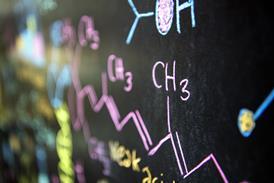All Organic chemistry articles – Page 12
-
 Resource
ResourceOn This Day - Jan 23 : Otto Diels was born
He was awarded the 1950 Nobel Prize in Chemistry alongside his student, Kurt Alder, for the discovery and development of the cycloaddition synthesis known as the Diels-Alder reaction. This reaction is widely used in chemical synthesis.
-
 Resource
ResourceFaces of Chemistry – Hair colourant
Learn about the chemistry of hair dyes from Procter and Gamble scientists.
-
 Resource
ResourceFaces of Chemistry – Crop protection
Discover how crop protection products from Syngenta help to increase yield and produce healthier crops.
-
 Feature
FeatureIt's not all about fuel
Biofineries produce heat, power and a plethora of useful 'platform chemicals'. Are they part of the solution to our renewable energy woes? Josh Howgego finds out
-
 Resource
ResourceOn This Day - Apr 10 : Robert Woodward was born
He is best known for his syntheses of complex organic substances, such as the antimalarial drug quinine, and the steroids cholesterol and cortisone. For this, he was awarded the Nobel Prize in Chemistry in 1965.
-
 The Mole
The MoleSniffing out an explanation
It’s strange to think that no one knows exactly how smell works. Josh Howgego explains the chemistry behind the puzzle
-
 Resource
ResourceOn This Day - May 22 : Herbert Brown was born
He shared the Nobel Prize in Chemistry in 1979 with Georg Wittig for their contributions to the use of boron- and phosphorous-containing compounds. These compounds are important reagents which are now routinely used in organic synthesis.
-
 Resource
ResourceOn This Day - Mar 12 : William Perkin was born
Credited with founding the organic chemical industry, Perkin discovered mauveine dye by accident when working with coal tar. Realising the commercial potential of this new purple dye, Perkin patented his synthetic process when he was just 18.
-
 Resource
ResourceOn This Day - Oct 09 : Hermann Fischer was born
He developed the Fischer esterification reaction and the Fischer projection model for drawing asymmetic carbon atoms. His most famous work was on sugars, and his greatest success was the synthesis of glucose, fructose and mannose from glycerol.
-
 Resource
ResourceOn This Day - May 06 : Victor Grignard was born
He developed the use of organomagnesium halides, now known as Grignard reagents, as a new method to make carbon-carbon bonds. This important reaction is widely used in synthetic organic chemistry.
-
 Resource
ResourceOn This Day - Apr 05 : Synthesis of morphine
Morphine was first isolated from dried poppy resin in the early 1800s and remains the best drug for relieving severe pain. Morphine is named after Morpheus, the Greek god of dreams.
-
 Resource
ResourceOn This Day - Feb 17 : Beilstein was born
He published a still-popular standard reference work on organic chemistry, called the “Handbuch der organischen Chemie”. It contained approximately 2,200 pages on 15,000 organic compounds.
-

-
 Resource
ResourceStructure and Bonding
Knowledge of structure and bonding can help explain the properties of materials. All the properties of a particular substance depend upon the elements present and how they are bonded to each other. This programme is designed to develop students understanding of structure and bonding as well as developing thinking ...
-
 Resource
ResourceSynthesis and Analysis
Synthesis and analysis are two key aspects of chemistry, particularly when exploring the role of chemistry in an industrial context and relating the products formed to applications in everyday life. In order to successfully synthesise any material it is necessary to have an understanding of the starting materials, the ...
-
![Feature microscale pg022 fig5 250 tcm18 216607[1]](https://d1ymz67w5raq8g.cloudfront.net/Pictures/100x67/9/4/2/113942_feature_microscale_pg022fig5_250_tcm182166071_353125.jpg) Feature
FeatureMicroscale chemistry revisited
Microscale techniques are unlikely to replace our traditional approach to chemistry education, but they do provide an extra dimension to our teaching strategies
-
 Exhibition chemistry
Exhibition chemistryEthyne and flying food cans
Demonstrations designed to capture the student's imagination
-
 Feature
FeatureThe hydrolysis of 2-bromo-2-methylpropane
A one hour experiment to determine the order of the reaction and show that it follows an SN1 mechanism
-
 Resource
Resource28 chemistry puzzles for 14-16 years
Use these sudoku-inspired puzzles with printable worksheets and answers to help 14–16 year olds consolidate their understanding of key chemical concepts.
-
 Resource
Resource45 chemistry puzzles for 16-18 years
Try these chemistry puzzles based on sudoku to help 16–18 year old students consolidate their knowledge about key topics, with printable worksheets and answers.











